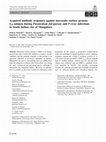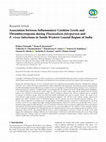Papers by Srinivas Kakkilaya

<p>Malaria positive patient blood samples from two collection sites, Peru (A), and Kenya (B... more <p>Malaria positive patient blood samples from two collection sites, Peru (A), and Kenya (B) were analyzed using PF-FISH assay. (A) Patient blood positive for <i>P</i>. <i>falciparum</i>. (B) Patient blood positive for <i>P</i>. <i>malariae</i> [<a href="http://www.plosone.org/article/info:doi/10.1371/journal.pone.0136726#pone.0136726.ref001" target="_blank">1</a>] <i>and P</i>. <i>falciparum</i> gametocyte [<a href="http://www.plosone.org/article/info:doi/10.1371/journal.pone.0136726#pone.0136726.ref002" target="_blank">2</a>]. (C) Patient blood positive for <i>P</i>. <i>ovale</i>. (D) Patient blood positive for <i>P</i>. <i>vivax</i>. Green fluorescence is due to the <i>P</i>. <i>falciparum</i> specific probe and red fluorescence due to the <i>Plasmodium</i> genus probe.</p
<p>Smear prepared from finger-prick capillary blood without anticoagulant. Green fluorescen... more <p>Smear prepared from finger-prick capillary blood without anticoagulant. Green fluorescence indicates the presence of <i>Plasmodium</i> ribosomal RNA (rRNA) due to reaction with <i>Plasmodium</i> genus FISH.</p
<p>N/A—not applicable.</p
<p>Malaria positive patient blood samples from two collection sites, Peru (A), India (B) an... more <p>Malaria positive patient blood samples from two collection sites, Peru (A), India (B) and Kenya (C-E) were analyzed using PV-FISH assay. (A) Patient blood positive for <i>P</i>. <i>vivax</i>. (B) Patient blood positive for <i>P</i>. <i>vivax</i>. (C) Patient blood positive for <i>P</i>. <i>ovale</i>. (D) Patient blood positive for <i>P</i>. <i>malariae</i>. (E) Patient blood positive for <i>P</i>. <i>falciparum</i>. Green fluorescence is due to reactivity with the <i>P</i>. <i>vivax</i> specific probe and red fluorescence is due to reactivity with the <i>Plasmodium</i> genus probe.</p
<p>After discrepant analysis: Including FISH and PCR positive but Giemsa negative samples a... more <p>After discrepant analysis: Including FISH and PCR positive but Giemsa negative samples as true positives”. P-Genus FISH -17; PF-FISH– 5; and PV-FISH– 14. CI—confidence interval.</p
<p>After discrepant analysis: Including FISH and PCR positive but Giemsa negative samples a... more <p>After discrepant analysis: Including FISH and PCR positive but Giemsa negative samples as true positives.” P-Genus FISH -17; PF-FISH– 5; and PV-FISH– 14. CI—confidence interval.</p
<p>Blood smears prepared from <i>P</i>. <i>falciparum</i> positive ... more <p>Blood smears prepared from <i>P</i>. <i>falciparum</i> positive patient before (0 Hrs) and after 24 hours (24Hrs) drug treatment were analyzed by <i>Plasmodium</i> Genus FISH assay. The disappearance of the <i>Plasmodium</i> Genus fluorescence signal at 24 hours suggests that FISH assay only detects live <i>Plasmodium</i> parasites.</p

Malaria is a responsible for approximately 600 thousand deaths worldwide every year. Appropriate ... more Malaria is a responsible for approximately 600 thousand deaths worldwide every year. Appropriate and timely treatment of malaria can prevent deaths but is dependent on accu-rate and rapid diagnosis of the infection. Currently, microscopic examination of the Giemsa stained blood smears is the method of choice for diagnosing malaria. Although it has limited sensitivity and specificity in field conditions, it still remains the gold standard for the diagno-sis of malaria. Here, we report the development of a fluorescence in situ hybridization (FISH) based method for detecting malaria infection in blood smears and describe the use of an LED light source that makes the method suitable for use in resource-limited malaria endemic countries. The PlasmodiumGenus (P-Genus) FISH assay has a Plasmodium genus specific probe that detects all five species of Plasmodium known to cause the dis-ease in humans. The P. falciparum (PF) FISH assay and P. vivax (PV) FISH assay detect and differentiate betw...

Archives of Mental Health, 2014
Background: Foreign body aspiration is a common life threatening emergency, but, largely a preven... more Background: Foreign body aspiration is a common life threatening emergency, but, largely a preventable problem. The object aspirated depends on various factors, such as age, sex, occupation, geographical area, socio-cultural factors, economic status, and nutritional habits. In recent years some traditional/social habits and fashion trends of using headscarf/ hijab pins have become a discrete category of foreign body aspiration in young Muslim/Islam girls wearing headscarves. Objective: To highlight the increasing number of cases coming to clinical attention with headscarf pin aspiration. India having a growing population which is young and fashion oriented, the awareness of this problem needs to improve. Discussion: In recent times young adolescent Muslim girls use multiple matching small headscarf pins to fix the hijab as a fashion trend. Adolescent girls and adults tend to hold the headscarf pin between their lips while wearing the headscarves using their two hands to secure the v...

The aim of this study was to assess the extent of oxidative and antioxidant stress responses duri... more The aim of this study was to assess the extent of oxidative and antioxidant stress responses during malaria in the endemic settings of Mangaluru in India. We also assesed the possible role of oxidative stressduring mild and severe malaria, malarial anemia and malarial thrombocytopenia. The blood samples from 54healthy controls,202mild malaria and 72 severe malaria patients with P. falciparum, P. vivax, and mixed infectionswere analyzed for the levels of malondialdehyde, uric acid, superoxide dismutase, TNF-α, IL-6 and IL-10. The data was analysed by Kruskal-Wallis, MannWhitney U test and were correlated by Pearson correlation and spearman rank correlations.Compared to healthy controls, the mean malondialdehyde and uric acid levels were significantly higher in malaria patients, especially during severeP. falciparum cases. The malondialdehyde levels were directly proportional to increase in parasitic burden, C-reactive protein, uric acid and TNF-α levels. In contrast, an inverse relat...

Journal of Parasitic Diseases
Merozoite surface protein-1 (MSP-1) of malaria parasites has been extensively studied as a malari... more Merozoite surface protein-1 (MSP-1) of malaria parasites has been extensively studied as a malaria vaccine candidate and the antibody response to this protein is an important indicator of protective immunity to malaria. Mangaluru city and its surrounding areas in southwestern India are endemic to malaria with Plasmodium vivax being the most widespread and prevalent species although P. falciparum also frequently infects. However, no information is available on the level of protective immunity in this population. In this regard, a prospective hospital-based study was performed in malarial patients to assess antibody responses against the 19-kDa C-terminal portion of P. vivax and P. falciparum MSP-1 (MSP-1 19). Serum samples from 51 healthy endemic controls and 267 infected individuals were collected and anti-MSP-1 19 antibody levels were analyzed by ELISA. The possible association between the antibody responses and morbidity parameters such as malarial anemia and thrombocytopenia was & Rajeshwara N.

Malaria Research and Treatment
Background. Thrombocytopenia is a most commonly observed complication during malaria infections. ... more Background. Thrombocytopenia is a most commonly observed complication during malaria infections. Inflammatory cytokines such as IL-1, IL-6, and IL-10 have been documented in malaria induced thrombocytopaenia. This study was aimed to understand the possible relationship between inflammatory cytokines across varying degrees of thrombocytopenia during P. vivax, P. falciparum, and mixed infections. Methods. A hospital-based cross sectional study was conducted at District Wenlock Hospital in Mangaluru, a city situated along the south-western coastal region of Arabian Sea in India. In this study, blood samples from 627 malaria patients were analyzed for infected parasite species, clinical conditions, platelet levels, and key cytokines that are produced in response to infection; samples from 176 uninfected healthy individuals were used as controls. Results. The results of our study showed a high prevalence of malarial thrombocytopenia (platelets <150 ×103/μl) in this endemic settings. A...
Informatics in Medicine Unlocked

The American Journal of Tropical Medicine and Hygiene
Dakshina Kannada district in the Southwestern region of Karnataka state, India, including Mangalu... more Dakshina Kannada district in the Southwestern region of Karnataka state, India, including Mangaluru city is endemic to malaria. About 80% of malaria infections in Mangaluru and its surrounding areas are caused by Plasmodium vivax and the remainder is due to Plasmodium falciparum. Malaria-associated clinical complications significantly occur in this region. Here, we report the pathological conditions of 41 cases of fatal severe malaria, admitted to the district government hospital in Mangaluru city during January 2013 through December 2016. The results of clinical, hematological, and biochemical analyses showed that most of these severe malaria cases were associated with thrombocytopenia, anemia, metabolic acidosis, acute respiratory distress, and single or multi-organ dysfunction involving liver, kidney, and brain. Of the 41 fatal malaria cases, 24, 10, and seven patients had P. vivax, P. falciparum, and P. vivax and P. falciparum mixed infections, respectively. These data suggest that besides P. falciparum that is known to extensively cause severe and fatal malaria illnesses, P. vivax causes fatal illnesses substantially in this region, an observation that is consistent with recent findings in other regions.

Malaria journal, Jan 19, 2017
Malaria is highly prevalent in many parts of India and the Indian subcontinent. Mangaluru, a city... more Malaria is highly prevalent in many parts of India and the Indian subcontinent. Mangaluru, a city in the southwest coastal region of Karnataka state in India, and surrounding areas are malaria endemic with 10-12 annual parasite index. Despite high endemicity, to-date, very little has been reported on the epidemiology and burden of malaria in this area. A cross-sectional surveillance of malaria cases was performed among 900 febrile symptomatic native people (long-time residents) and immigrant labourers (temporary residents) living in Mangaluru city area. During each of dry, rainy, and end of rainy season, blood samples from a group of 300 randomly selected symptomatic people were screened for malaria infection. Data on socio-demographic, literacy, knowledge of malaria, and treatment-seeking behaviour were collected to understand the socio-demographic contributions to malaria menace in this region. Malaria is prevalent in Mangaluru region throughout the year and Plasmodium vivax is pr...








Uploads
Papers by Srinivas Kakkilaya